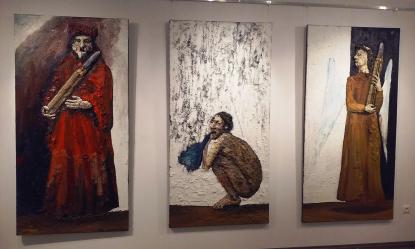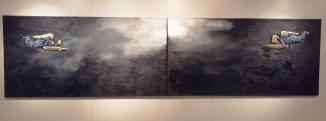2024. April 29. Monday
Agora - Együd Árpád Cultural Center - Kaposvár
 |
Address: 7400, Kaposvár Csokonai u. 1.
Phone number: (82) 314-915
E-mail: vaszary@dravanet.hu
Opening hours: Tue-Sat 10-18
|
The exhibition has closed for visitors.
2015.08.13. - 2015.10.15.
Museum tickets, service costs:
|
Ticket for adults
|
1000 HUF
|
|
|
Ticket for students
|
500 HUF
|
|
|
Ticket for pensioners
|
500 HUF
|
|
|
Ticket for families
(2 adults + 2 children)
|
2000 HUF
|
/ family
|
The visitors will find dark and disturbing images at the Vaszary gallery in Kaposvár: the first approach of the painter József Baksai is a journey back in time, to the world of cult. His journey however is an inward one, a meditation, during which he penetrates the ever deeper layers of his soul.

The artist graduated from the Hungarian Academy of Fine Arts where his tutor was Lajos Sváby in the second half of the 80s,. Within modern fine, he represents expressive language filled with dramatic force and romantic roots. What preceded his deep art was the art of László Mednyánszky László, Tivadar Csontváry Kosztka, but also Rembrandt or Goya even more back in time, or Arnulf Rainer and Francis Bacon. Like them deep, Baksai peeps into the deep cardoon of the human soul and looks in terms of material at the demonic inside people and depicts what is tragic.
Baksai works with pagan and Judeo-Christian legends archaic text and imagery, leaving out narrative details, reducing cult scenes into their elements of the cult scenes, and sometimes enhancing metaphorical objects. Typical of early Christian art, he focuses on emblematic terms. His most peculiar means of expression is the plastic handling: he kneads and forms his images by hand. The facture has an intensive effect. Due to the figures and the method he chose to apply paint he dramatizes visual happening, making them emotional.
Baksai imagery in its extreme nudity, abstraction is striving toward the transcendent and revives mystery hidden within things. He confronts us, the viewers, with time, the loneliness, suffering and death, ultimately the eternal secrets. His symbolic world creates passages between conflicting realities: In his pictures we see beside sacred, mythical, liturgical fancies a diabolical and dark content to drive us towards the inner purgation, illumination and perfection.

The artist graduated from the Hungarian Academy of Fine Arts where his tutor was Lajos Sváby in the second half of the 80s,. Within modern fine, he represents expressive language filled with dramatic force and romantic roots. What preceded his deep art was the art of László Mednyánszky László, Tivadar Csontváry Kosztka, but also Rembrandt or Goya even more back in time, or Arnulf Rainer and Francis Bacon. Like them deep, Baksai peeps into the deep cardoon of the human soul and looks in terms of material at the demonic inside people and depicts what is tragic.
Baksai works with pagan and Judeo-Christian legends archaic text and imagery, leaving out narrative details, reducing cult scenes into their elements of the cult scenes, and sometimes enhancing metaphorical objects. Typical of early Christian art, he focuses on emblematic terms. His most peculiar means of expression is the plastic handling: he kneads and forms his images by hand. The facture has an intensive effect. Due to the figures and the method he chose to apply paint he dramatizes visual happening, making them emotional.
Baksai imagery in its extreme nudity, abstraction is striving toward the transcendent and revives mystery hidden within things. He confronts us, the viewers, with time, the loneliness, suffering and death, ultimately the eternal secrets. His symbolic world creates passages between conflicting realities: In his pictures we see beside sacred, mythical, liturgical fancies a diabolical and dark content to drive us towards the inner purgation, illumination and perfection.


